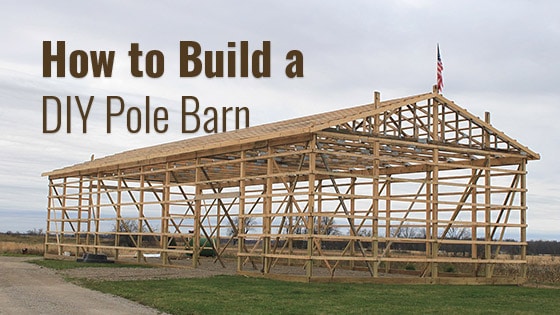Monday, November 11, 2024
How to Make a Pole Barn with a Traditional Design and Modern Function

The pole barn, a stalwart of rural landscapes, has long been a symbol of practicality and durability. Its simple, sturdy design, often adorned with the charm of weathered wood and rustic accents, evokes a sense of heritage and functionality. Yet, in today's world, where form follows function and modern needs dictate design, it's possible to blend the traditional essence of the pole barn with contemporary elements, creating a structure that is both visually pleasing and highly functional.
Embracing the Classic Elements:
The foundation of a successful pole barn design lies in understanding and celebrating its traditional attributes. These include:
Open Floor Plan: The signature open space within a pole barn, unhindered by interior walls, provides flexibility for various uses, whether it's a workshop, storage space, or even a living area. This open layout creates a sense of spaciousness and allows for adaptability over time.
Post-and-Beam Construction: The defining feature of a pole barn is its robust post-and-beam framework. These large, visible timbers, often made from durable hardwoods like oak or pine, convey strength and stability, contributing to the building's rustic appeal.
Simple Rooflines: Typically featuring a gable roof or a shed roof, pole barns prioritize functionality over intricate designs. This simplicity allows for easy drainage and minimizes material waste.
Natural Ventilation: Pole barns traditionally rely on open vents and doors for air circulation. This natural ventilation promotes a healthy indoor environment, particularly beneficial for workshops or storage spaces.
Incorporating Modern Functionalities:
While respecting the traditional elements, modern pole barns can incorporate features that enhance functionality and aesthetics:
High-Efficiency Insulation: To counter the inherent openness of a pole barn and create a comfortable indoor environment, consider using high-performance insulation within the walls and roof. Modern insulation technologies like spray foam or blown-in cellulose offer excellent thermal resistance while minimizing drafts.
Energy-Efficient Windows and Doors: Strategically placed windows and doors can flood the space with natural light, minimizing the need for artificial lighting. Consider using energy-efficient glazing and framing to reduce heat loss in colder climates.
Advanced Roofing Materials: Beyond traditional metal roofing, modern options like standing seam metal roofs offer increased durability, water resistance, and aesthetic appeal. They can be customized with various colors and finishes to complement the chosen style.
Modern Electrical and Plumbing Systems: To accommodate modern lifestyles, ensure the pole barn is equipped with a well-designed electrical system, including sufficient outlets, lighting, and potentially even a sub-panel for specific appliances. If needed, incorporate a plumbing system for sinks, restrooms, or even a small kitchen.
Interior Finishing Touches: Modern pole barns can utilize a range of interior finishes to create specific ambiance and functionality. While exposed beams and rustic wood accents retain the traditional charm, they can be combined with polished concrete floors, painted walls, and modern fixtures to achieve a contemporary aesthetic.
Bridging the Gap:
The key to achieving a successful balance between traditional charm and modern functionality lies in thoughtful design choices:
Exterior Cladding: Embrace the classic wood siding while exploring modern finishes. Opt for reclaimed wood, weathered barn board, or even a combination of wood and metal panels to achieve a rustic yet contemporary look.
Roofline Features: While keeping the roofline simple, consider incorporating dormers, overhangs, or strategically placed windows to add visual interest and provide additional light and ventilation.
Lighting: Use a combination of natural light and strategically placed LED fixtures to illuminate the space effectively. Exposed Edison bulbs, lanterns, or modern track lighting can all add character and functionality.
Color Palette: The color scheme plays a crucial role in setting the overall tone. Embrace warm, earthy tones like browns, greens, and blues, while using accents of bold, modern colors to add pops of visual interest.
Landscaping: The surrounding landscape can complement the barn's design. Consider incorporating native plants, water features, or even a small garden to create a harmonious and welcoming environment.
Beyond Aesthetics:
The modern pole barn offers a wealth of opportunities beyond aesthetics:
Sustainable Building Practices: Choose locally sourced materials whenever possible, prioritize recycled or repurposed elements, and minimize waste during construction to create an environmentally conscious building.
Multi-Functionality: A modern pole barn can be adapted to suit a variety of uses, serving as a workshop, garage, guest house, home office, or even an event space. Its versatility makes it an ideal investment for various lifestyles.
Increased Resale Value: A well-designed and functional pole barn can significantly increase the value of a property. The combination of rustic charm and modern amenities creates a highly desirable and unique structure.
In Conclusion:
Building a pole barn with a traditional design and modern function is about honoring the past while embracing the present. By understanding the core principles of the pole barn aesthetic and integrating them with modern design elements, you can create a structure that is both aesthetically pleasing and practical, offering a unique blend of heritage and contemporary living.
No comments:
Post a Comment
Note: Only a member of this blog may post a comment.